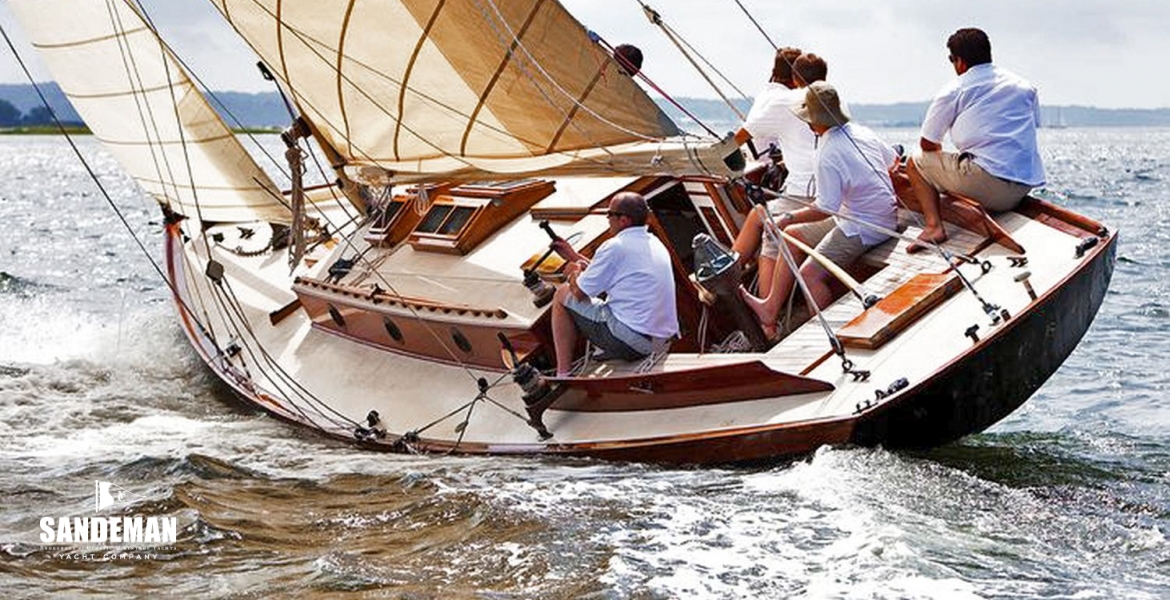
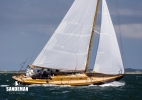
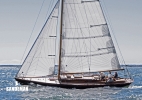
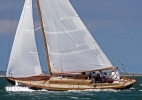
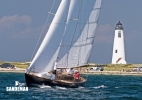
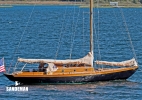
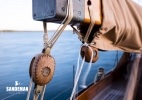
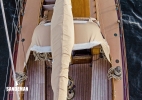
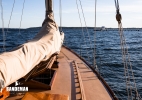
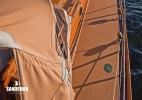
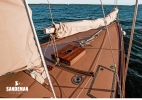
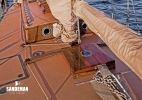

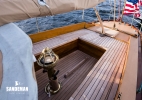
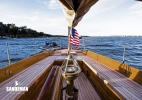
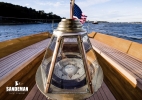
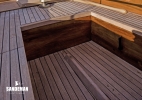
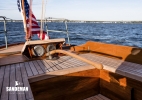
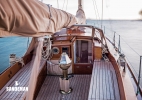
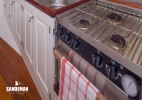
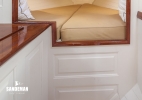
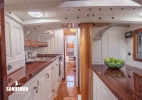
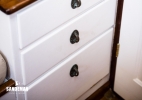
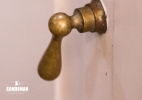
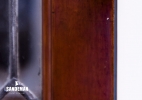
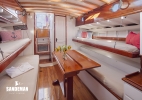
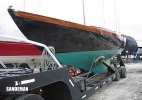
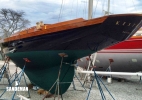
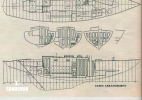
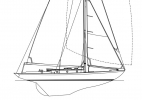
| Designer | Herreshoff Nat G & Sid |
|---|---|
| Builder | Herreshoff Mfg Co Bristol RI |
| Date | 1929 |
| Length overall | 43 ft 4 in / 13.2 m |
| Length deck | 43 ft 4 in / 13.2 m |
| Length waterline | 31 ft 0 in / 9.45 m |
|---|---|
| Beam | 10 ft 8 in / 3.25 m |
| Draft | 5 ft 11 in / 1.8 m |
| Displacement | 9 Tonnes |
| Construction | Pine and Cedar part double planked on oak frames |
| Engine | Yanmar 40 HP Diesel |
|---|---|
| Location | USA |
| Price | Sold |
These details are provisional and may be amended
In a taped interview in 1975 Sid Herreshoff spoke of the origins of the class being derived from the Newport 29 design and an improvement on ALERION III. Then Herreshoff’s original marketing claimed”....the boats are the result of years of careful study to develop a model which is exceptionally sturdy, seaworthy and dry in rough going........!
KESTREL and her sisters have not disappointed and this special boat has been rewarded by a recent careful ownership and restoration. This design can be pushed hard around the classic regatta circuit yet with her generous cockpit and comfortable interior, she will cruise with the kids and probably with less fuss than many a modern boat.
Interested in KESTREL in more detail.
In the 1990s under the ownership of Geoffrey Davis; Narrangansett Shipwrights led by the late Frank McCaffrey restored KESTREL. The major works involved replacing many of the frames, planking and deck as well as updating systems. At that time the boat was re rigged to a fractional sloop rig designed by Halsy Herreshoff and based on one of the later Herreshoff Mfg Co sail plans, giving the boat slightly more sail than the earlier plans which were deliberately slightly undersized. The rig – and all spars of carbon fibre was built by Hall Spars; one of the early forays into the use of carbon fibre technology.
In the more recent refit, Angus decided to replace her Hall carbon fibre spars with new spars made of Sitka spruce – so of similar construction to those originally fabricated by Herreshoff in 1927. The team of Mt. Hope Boatworks (Jim Titus) and East Passage Boatwrights (Seth Hagan & Carter Richardson) collaborated on the construction of new spars, with naval architecture by Matt Smith. The wood mast is lightly built with eight staves of Sitka spruce; only 34 pounds heavier than the carbon mast built by Hall Spars in the mid 1990s. Hall Spars again however provided standing rigging, this time with more traditional construction technique.
Other works included in this refit were:
- Some frames replaced
- Planking refastened
- New winches as detailed
- New Awlgrip paint
- Complete varnish restoration
- New sails
- New running rigging
- New covers
- New mechanical systems (except engine)
- New hot water system,
- New air conditioning
- New cosmetics
While KESTREL was built in 1927 she was not delivered to her owner until 1929, being given that year of build in the Hereshof Mfg Co order book. The Company built only 14 of these Fisher Island 31s, which have nonetheless been widely recognised as among the greatest ever all-round yacht designs. One of KESTREL’s sisters is the featured exhibit in the Herreshoff Marine Museum and various of the FI 31s have been the subject of article featured in the yachting press; notably “Wooden Boat”.
Having restored KESTREL in the 1990s at Narrangansett Shipwrights, her owner Geoffrey Davis went on to campaign the boat - with care provided by Bristol, RI's Lars Guck. In 2009 Davis donated KESTREL to the Herreshoff Marine Museum, where she became the Museum's flagship yacht for use in educational programs and promoting the mission of the Museum. Under the care of HMM's Richard Feeny, KESTREL took children around the northeast from all walks of life for sailing adventures. In 2013, the Herreshoff musuem decided to sell KESTREL, and the Davis family agreed to buy her back, with Geoffrey's son Angus taking the lead this time with a major refit also carried out Narrangansett Shipwrights.
Notwithstanding the restoration in the 1990s and substantial recent refit; KESTREL remains highly original. She retains her original main cabin layout and an extraordinary amount of original joinery detail. This includes the main cabin panelling, cabinetry, leaded glass doors, etc. She still has the original Herreshoff steering compass and binnacle. On deck there are two of the original skylights, all of the hatches as well as the opening cabin ports.
The Fisher's Island 31 Footer Class dates back to 1926, when Barklie Henry contracted the first one, but earlier Herreshoff designs are the basis for the class. Indeed it is based directly on Captain Nat Herreshoff's famous half-model for his own well-known boat, ALERION, now on display at Mystic Seaport, and which design is still built to this day. This same half model was used for the Newport 29s and influenced such other outstanding Herreshoff hollow bow designs as the Buzzards Bay 25. Lines for the FI 31s were laid out by Nat's son Sidney and resulted in an exceptionally dry, comfortable boat with reasonable cruising accommodation. Knowledgeable commentators from Waldo Howland (whose first major brokerage project for Concordia consisted of the purchase and refitting of six FI 31s) to Maynard Bray have consistently praised the FI 31s as exceptional boats. KESTREL's sister ship, PATAPSCO II, completed a circumnavigation. KESTREL herself during her long and caring ownership by the Tarbell family completed most of the major northeast ocean races including Halifax and Bermuda. KESTREL's sister ship, CIRRUS, re-rigged as a yawl by Joel White for her then owner Alan Bemis, is featured in Benjamin Mendlowitz's famous coffee table book, "Wooden Boats."
There has always been discussion on to whom the credit should be given for this design. In a taped interview with Maynard Bray and Barry Thomas on October is, 1975, Sid Herreshoff spoke of the origins of the class when discussing the alterations to the ALERION III model designed by Captain Nat Herreshoff. Sid explained that the lines of the Fisher's Island 31s were derived from the Newport 29 class, a keel version of SADIE, which was a 1914 improvement on ALERION IlI. When asked whether the same model was used for the Fisher's Island 31s, Sid responded; “Yes - but the ends were doctored, some in the overhangs both forward and aft.” He also added that the lead was further down, making the 31 a little deeper. To Thomas' remark “The Fisher's Island 31 profile was changed quite a bit. She's quite a bit longer on deck,” Sid Herreshoff replied, “The Fisher's Island 31 Footers were designed when my father was away. I was the one who laid down the boat.” The credit for the design must therefore be shared by the father and son team of Nat and Sid Herreshoff with the lion's share of it going to the son.
(Some text in this paragraph is reproduced from that by the display of TORCH ex SAVAGE #1153, another Fishers Island 31 currently at the Herreshoff Marine Museum in Bristol, RI).
These boats are the result of years of careful study to develop a model which is exceptionally sturdy and seaworthy and dry in rough going, without sacrificing the element of speed which is so much to be desired in a sail boat. The forward section is sharp enough to prevent pounding under any condition, and is sufficiently flaring to prevent the boat from throwing water even when being driven hard to windward in rough weather. They are large enough to give head room and elbow room and plenty of storage space for cruising equipment and accommodation, and yet are rigged with a conservative sail plan so that one man can get the boat under way and put it up under any weather conditions without it being a hardship. While every care and precaution has been taken to make these boats as able, seaworthy and pleasant handling as is possible under bad weather conditions, equal provision has been made to prevent loss of speed under sail. Their performances in the New York Yacht Club runs and in the 1929 Gibson Island race have clearly demonstrated their ability.
- Yellow pine single planking below WL
- Douglas fir external and cedar double planking above WL
- Bronze screw fastenings
- White oak frames
- White oak stem, keel and stern
- Dynel sheathed pine deck on ash deck beams
- Teak deck house and hatches with canvassed pine tops
- Teak cockpit sole
- Soft wood interior joinery with mahogany trim
From aft
- Varnished toe rail
- Bronze fairleads each side and ensign staff socket
- Bronze pushpit, stanchions and stainless steel guard wires running forward each side
- Bronze ring mooring rings on deck each side
- Bronze main sheet track
- Tapered coamings forward each side of cockpit
- Varnished lazarette hatch also housing on – deck speakers
- Bronze and wood hinged tiller steering
- Raw teak planked cockpit seating aft
- Raw teak planked cockpit seating lifting over hatches each side
- Teak planked cockpit sole, raised foot rest up centreline
- Engine controls to port
- Original Herreshoff binnacle for steering compass
- Leather winch handle holsters around base
- Bronze cleats in coamings outboard with reinforcing brackets inboard
- 2 x Harken Classic bronze ST sheet winches on bronze pedestals outboard
- Bronze cleats in coamings outboard with reinforcing brackets inboard
- Raised trunk cabin fwd
- Bronze surrounded port light in aft port bulkhead
- Navigation repeaters port side by companionway
- Harken Classic bronze ST winch on coach roof to port
- Lifting hatch with port light over to port
- Wash boards and sliding hatch access to accommodation to stbd
- Lifting spray hood fwd
- Reduced height trunk cabin fwd with 4 x bronze framed port lights each side
- Varnished teak handrails full length of coach roof each side
- Stowage for boarding ladder and boat hook on coach roof to port
- Harken Classic bronze ST winch offset to stbd on coach roof
- Large butterfly skylight
- Small butterfly skylight
- Navigation lights fore end of trunk cabin
- 2 x Bronze port lights in trunk cabin fwd
- Mast and boom
- Lemon squeezer skylights in deck each side
- Foresail boom track
- Varnished fore hatch with port light
- Danforth anchor stowed on deck and chain
- Bronze mooring rings fwd
- Bronze fairleads each side
- Companionway steps down over engine housing
- White painted deck head contrast with varnished deck beams and joinery
- Excellent lighting by port and skylights
Saloon
- Period lights on aft bulkhead
- Settee berths each side with stowage under
- Lifting pilot berths above
- Fiddled drop leaf dining table
- Locker and shelf stowage forward to port
- Access to head compartment with WC and basin port side before mast
- Doorway to galley fwd and stbd by mast
Galley
- Force 10 three burner hob, grill and oven
- Open shelving up and outboard
- Stainless steel sink with mixer, salt water and fresh water taps
- Varnished work surface with large lockers under and smaller lockers above and outboard fwd
- Work surface and fridge freezer to port by mast
- Lemon squeezer deck lights over
- Cabinets above and outboard
- Aperture forward accommodation
- Forehatch with skylight port over
Forecabin
- Double vee berth
- Stowage under
- Reading lights in bulkhead aft
- Chain locker fwd
- Sloop rig with boomed foresail
- Sitka spruce mast and booms
- Bronze mast and boom fittings
- Stainless steel standing rigging
- Leather encased ash blocks
- Jib
- Genoa
- Mainsail
- Cover for forsail
- Cover for mainsail
- Leather cased ash blocks
- Yanmar 40 HP Diesel
- Mastervolt inverter
- Alternator
- 2 x LI Domestic batteries in pack
- 1 x LI Engine start battery
- Mastervolt master panel
- Shore power
- Cruise air conditioning
- AC and 12 V outlets
- Fwd fresh water tank c 50 gallons
- 2 x 75 gallon fresh water side tanks
- Negus New York steering compass in the cockpit binnacle
- B&G Chart plotter
- VHF
- 4 x J1 loudspeakers
Contact us to discuss KESTREL in more detail.
These particulars have been prepared from information provided by the vendors and are intended as a general guide. The purchaser should confirm details of concern to them by survey or engineers inspection. The purchaser should also ensure that the purchase contract properly reflects their concerns and specifies details on which they wish to rely.